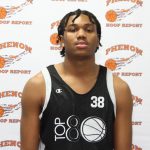Yesterday, we introduced our “Underrated and Scholarship-Worthy” series, which took a closer look at a variety of deserving prospects. Today’s article will do the same thing, highlighting scholarship-worthy guys that currently do not hold offers. College coaches should certainly take the following prospects seriously, as each of them could become a major contributor at the next level…
6’7 ’20 Jefferson Boaz (East Surry/PSB Elite)

Earlier this year, we wrote about Boaz potentially being the best three-sport athlete in North Carolina. Since then, he led East Surry basketball to the second-round, has been phenomenal on the baseball diamond, and is starting to accumulate a ton of football scholarships. It’s easy to see the appeal with Boaz as a football player, especially given his size, but he’s arguably even more unique on the hardwood. He’s big, strong, and athletic, but it’s his versatility and well-rounded skillset that separates him from similar prospects. Boaz can rebound, handle the ball, create for himself or others, and scores efficiently from all levels. He’s a matchup problem for opponents and could thrive in numerous different systems.
6’8 ’20 Sam Hood (Millbrook/Garner Road)

There are a lot of quality big men in the Hoopstate right now, but Hood might be the most underrated of them all. Last year, he showed flashes of dominance with the Durham Hurricanes and has continued to elevate his game ever since. Hood is a modern-style big man with size, athleticism, and the ability to score in a variety of different ways. He runs the two-man game exceptionally well and is capable of rolling or popping, which both yield fantastic results. Hood plays extremely tough on defense and possesses excellent rim-protecting instincts, which allows him to alter an abundance of shots around the basket. Hood maximizes his role on both ends of the floor and will be an effective player wherever he ultimately decides to attend.
6’2 ’20 Jackeem Herbin (Burlington Christian/NC Red Storm)

Nowadays, the term “combo-guard” often represents a player with too many holes to solely play one backcourt position. However, Herbin is a combo-guard for all the right reasons. He can play full-time at either spot and make a quality impact on the game. Herbin has an excellent blend between playmaking and three-level scoring, which allows him to operate as a lead creator whenever needed. He has very strong court vision and handles the ball quite well. Herbin can generate clean looks off the bounce, attack the basket, or spot-up from beyond the arc—all at a useful level. He utilizes his body well to absorb contact when penetrating and has the necessary athleticism to play above the rim. Herbin’s trajectory has skyrocket over the last calendar year and should continue trending upward over these next few months.
6’7 ’20 Evan Joyner (Piedmont Classical/Garner Road)

Perhaps no player on this list is more unique than Joyner, who is already somewhat of a point-forward at the high school level. At 6-foot-7, he possesses a long list of favorable physical attributes, but has also showcased an incredible array of guard skills, especially for his size. Joyner has great two-way versatility, able to create/initiate offense while defending four positions comfortably on the other end. He’s a terrific rebounder, despite having true strength, and knows how to locate the ball with consistency. Joyner can knock down jumpers at a solid rate, but looks the best when getting downhill, attacking the basket, and utilizing his length to finish. He already has a strong feel for the game, but looks likely to continue developing into a two-way dynamo.
6’3 ’20 Zavian McLean (Village Christian/Team Wall)

Rounding things off, we look at McLean, who is arguably the most productive player within this article. He’s a long, athletic guard prospect that simply knows how to make plays and get things done on both sides of the ball. McLean has an impressive motor, which allows him to truly cause havoc as a defender, rebounder, and all-around offensive threat. He doesn’t have any glaring holes within his skillset and is capable of making his presence felt with or without the ball in his hands. McLean leads by example and does a great job of setting the tone on both ends of the floor. He utilizes his left-handedness to take advantage of the opposition, but can also finish quite well when going right. McLean rebounds the ball and pushes transition play at every opportunity. College coaches should start laying groundwork now, as McLean certainly won’t be available for too much longer.